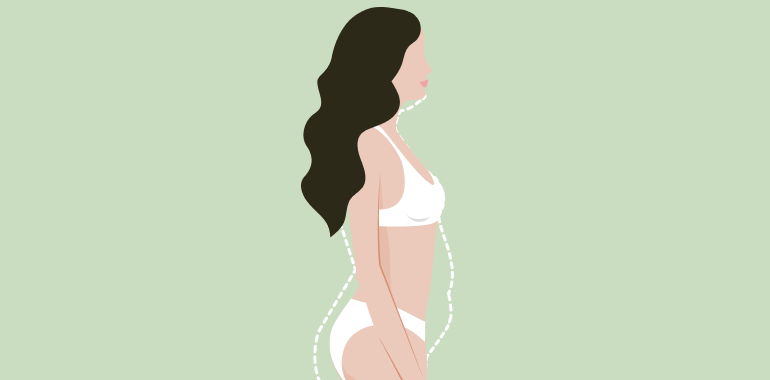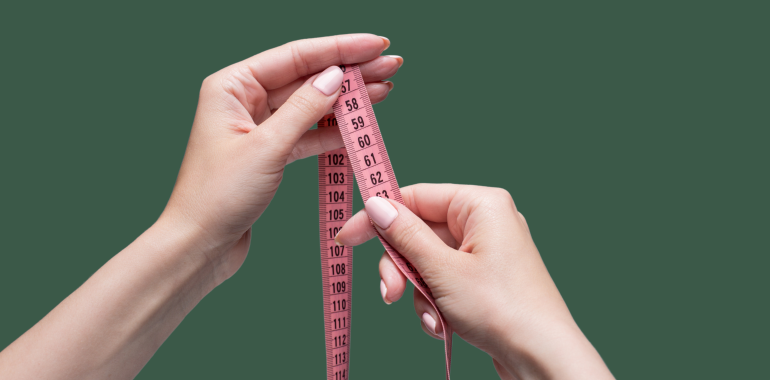Table Of Contents
We all shed some pounds here and there, but some areas definitely compare to others that shed more. Other sections of the body also stand to benefit from fat loss. Traditional fat loss diets emphasize the importance of changing the external environment to bring about changes in the body and various spheres of life. This reduced weight loss changes across groups based on genetic makeup and sex. In this article, we will help to determine where do you start losing weight first, irrespective of your gender.
What Part of the Body Loses Fat First? Get to Know Initially
This question often stems from the frustration many people feel when they don’t see immediate changes in certain areas of their bodies.
First, men and women tend to carry fat differently due to the influence of hormones like estrogen and testosterone. Typically, men store more fat around the abdomen (visceral fat), while women store more fat around the hips, thighs, and buttocks (subcutaneous fat).

Also, read – How Do You Get Rid of Face Fat?
Mark reduction isn’t an effective strategy for losing fat in specific areas. When you lose weight, your body decides where the fat comes off first.
Although you can’t control where your body loses fat first, some small signs you’re losing weight:
1. Visceral fat
Fat stored around internal organs (visceral fat) is often lost more quickly than subcutaneous fat because it is more metabolically active.
2. Upper body
Many people notice fat loss in the face, neck, and arms before other areas. This is because these areas typically have less fat to begin with.
3. Lower body
Areas like the hips, thighs, and buttocks may retain fat longer, especially in women, due to higher estrogen levels, which promotes fat storage in these areas.
Which Body Part Loses Fat First Woman Look? Checked Explore
In the first instance, most women shed pounds from their belly, abdomen, and breasts. Weight loss is also observed in the body’s lean tissue, and the final region is the hip and thigh region. The signs of weight loss in females tend to lose weight in their hips and thighs because, by default, she has big or expanded hips and thighs.
Weight loss in women may be attributable to dieting, exercise, or sometimes an illness. Women should pay attention to their weight to ensure it is well controlled.
Where Do You Lose Fat First Male Focus?
While weight reduction can be a function of genes, various research indicates that men tend to slim down first about their middle and the torso. The general rule expressed by this phrase means that the last one to gain you something is also the last one to lose you something. To illustrate, most men desire to remove some fats from their bellies, but most have failed.
Also, read – Is Pilates Good for Weight Loss?
Signs You’re Losing Belly Fat
Belly fat is painful for many people, and many are working hard to see it gone. Those concerned about belly fat have a legitimate reason because it can lead to further complications if it’s not taken seriously. Suppose you have put the necessary work into losing belly fat.
So, is losing 30 pounds noticeable? No way, if we talk about belly fat! But there are ways to monitor if your work is yielding positive results. Some of the signs you are losing belly fat include:
- You look more fit: when you lose belly fat, your natural shapes emerge, and you look younger and physically fit.
- Your clothes fit properly: Yes! When you begin to lose weight, you should notice a change in how your dress fits.
- You feel less hungry because you have replaced those carbs with healthier proteins and fiber-based diets.
- Your well-being improves: a potbelly can impair your self-esteem and overall psychological well-being.
So, when you lose belly fat, your overall psychological well-being improves.
Look Progressive Changes: Stages of Noticing Weight Loss
The human body has three stages of weight loss: glycogen depletion, fat loss, and metabolism. Read more about weight reduction and the human body.
1. The Glycogen depletion stage
The glycogen depletion stage is the time when all the solid glycogen in our body is used up, resulting from a lack of carbohydrates. This is the first weight loss stage, as you require carb deficiencies in the body before you can lose weight.
2. The fat loss stage
Immediately after the glycogen stage, excess fat starts being utilized in your body in place of carbohydrates. Since you have created an anabolic carb deficit, the body must then turn towards fat for energy production instead. The fat loss stage sets the stage for the next phase/level of the weight loss process. So, normally, it takes 4 weeks to notice weight loss.
3. Metabolic stage
The metabolic stage is when the body or the brain attains ketosis and starts to burn ketones. This is a crucial process in the weight loss plan that most individuals never achieve as they lack the patience to practice it.
How Long Does It Take to Notice Weight Loss? Form Real Expectation!
The timeline for losing weight varies according to an individual’s habits, nutrition, gender, and genetics. Generally, if you follow a diet and work out, you should start seeing signs of weight loss in the first week. Losing weight but not inches? – The first week is mostly due to water loss and not necessarily due to loss of fat.
It will take 3-4 weeks for a person to start seeing a noticeable change in their weight. For some people, it may take longer or shorter time.
Also, read – Baking Soda for Weight Loss – Shedding Pounds with Pantry Staples
Does Your Body Burn Fat or Muscle First?
Typically, your body tends to prioritize burning fat rather than muscle when you are eating calories as long as you are getting enough protein and doing resistance exercises. However, if you severely limit your calorie intake and don’t consume protein, it could result in the breakdown of muscle. Moreover, it can be the reason for losing weight everywhere but stomach pain sometimes...
Under normal circumstances of moderate caloric deficit and adequate protein intake, the body preferentially burns fat over muscle. However, several factors influence this process:
- Caloric deficit severity. A severe caloric deficit triggers muscle breakdown alongside fat loss.
- Protein intake. Adequate dietary protein helps preserve muscle mass during weight loss.
- Exercise type. Resistance training stimulates muscle synthesis and helps preserve muscle mass.
Numerous studies have demonstrated that increasing protein intake can aid in preserving muscle mass when trying to lose weight. For example, a study featured in the American Journal of Clinical Nutrition revealed that diets high in protein were effective in maintaining muscle mass while individuals shed pounds.
Incorporating resistance training into a weight loss plan has also been proven to be beneficial for preserving muscle mass. Research suggests that individuals who include resistance training in their weight loss efforts are able to retain muscle more effectively than those who solely focus on adjusting their diet.

Losing Weight vs Losing Fat – Explicit Such Ideas
| Losing Weight | Losing Fat |
| Reducing overall body mass, including muscle, fat, and water. | Specifically reducing the amount of fat in the body while preserving lean body mass. |
| Typically measured using a scale (total body weight). | Measured using body fat percentage tests, such as calipers, DEXA scans, or bioelectrical impedance analysis. |
| Weight loss affects fat, muscle, bone density, and water content. | Fat loss primarily targets adipose tissue while aiming to preserve muscle mass and other lean tissues. |
| Rapid weight loss without focus on fat can lead to muscle loss, nutritional deficiencies, and metabolic slowdown. | Fat loss with muscle preservation improves body composition, metabolic rate, and overall health. |
| Often involves calorie restriction without emphasis on macronutrient balance. | Emphasizes a balanced diet with adequate protein intake to support muscle maintenance. |
| May include cardio but often lacks resistance training if not properly planned. | Combines cardiovascular exercise with resistance training to optimize fat loss and muscle preservation. |
| Can be unsustainable if too restrictive, leading to potential rebound weight gain. | More sustainable when combined with proper nutrition and exercise, leading to long-term adherence and results. |
| May not lead to desired body shape; can result in a “skinny fat” appearance (thin but high body fat percentage). | Leads to improved body composition, defined muscles, and better overall aesthetics. |
| Can slow down metabolism due to muscle loss and lower overall energy expenditure. | Maintains or boosts metabolism by preserving muscle mass, thereby sustaining higher energy expenditure. |
| Rapid, non-targeted weight loss can lead to frustration and dissatisfaction if visual changes are not as expected. | More likely to result in positive self-image and satisfaction due to visible improvements in body composition. |
So, is losing fat the same as losing weight?
- Losing weight encompasses a reduction in total body mass, which can include muscle, fat, and water. It often leads to quick results but may not improve body composition effectively.
- Losing fat reduces adipose tissue while maintaining muscle mass, leading to improved body composition, better health outcomes, and a more sustainable and visually pleasing result.
Why Am I Losing Weight but Not Fat?
If you’re losing weight but not fat, it’s more likely that you’re losing muscle mass or water. This might happen if your diet is low in protein, you don’t do physical exercise, or you’re losing weight quickly.
To lose fat, follow a well-balanced diet with enough of protein, integrate strength training, and strive for steady, long-term weight loss.
Also, read – Do Cold Showers Burn Fat? The Most Unexpected Way Explained
Early Indicators: First Signs of Weight Loss
1. Wearing clothes that are a bit looser
As you shed some weight, you might start to feel your clothes fitting comfortably around your waist, hips, and thighs. This change is often one of the signs that you’re losing weight.
2. Feeling more energized
As you drop some pounds, you may find yourself having a boost in energy levels, making your daily tasks feel less tiring and more doable.
3. Brighter mood
Losing weight can trigger the release of endorphins, which can lift your spirits and lower feelings of tension and worry.
4. Sleep
Shedding extra pounds can enhance your sleep quality by reducing issues like sleep apnea and other disturbances that affect your rest.
5. Increased physical endurance
Tasks like walking, going upstairs, or working out will become less challenging as your endurance improves over time.
6. Noticing reduced swelling or lost inches
Before seeing differences on the scale, you might observe a decrease in puffiness or changes in measurements around areas like the waist, hips, arms, or legs.
7. Encouraging comments from others
Your friends, family members, or colleagues might start to notice shifts in your appearance and offer encouraging words as a form of support.
8. Enhancing digestive health
Shedding pounds, particularly when combined with adopting a diet can help alleviate digestive problems such, as bloating, constipation, and acid reflux.
9. Alleviating joint discomfort
Shedding excess weight can ease the pressure on your joints, resulting in decreased pain and enhanced flexibility.
10. Managing blood pressure
Even a slight weight reduction can lead to high blood pressure levels, which promotes heart health.
William is from Canada, he is passionate nutrition & wellness writer. William understands that the topic of wellness is still not well understood, so his goal is to enlighten and teach people how to live healthier and happier in their bodies.










I agree with the author of this article that men and women have different stages of weight loss. Does this mean that as a woman I have to walk more steps per day and where do I lose fat first?
Hi, Eliza🙂
Each body is unique, but generally, women and men may experience weight loss differently. As for steps per day, focus on what feels right for you and fits into your lifestyle. Regarding fat loss, it varies, but often starts in different areas for men and women. For women, it might begin in parts of the body with little fat content, and the last area is their hips.